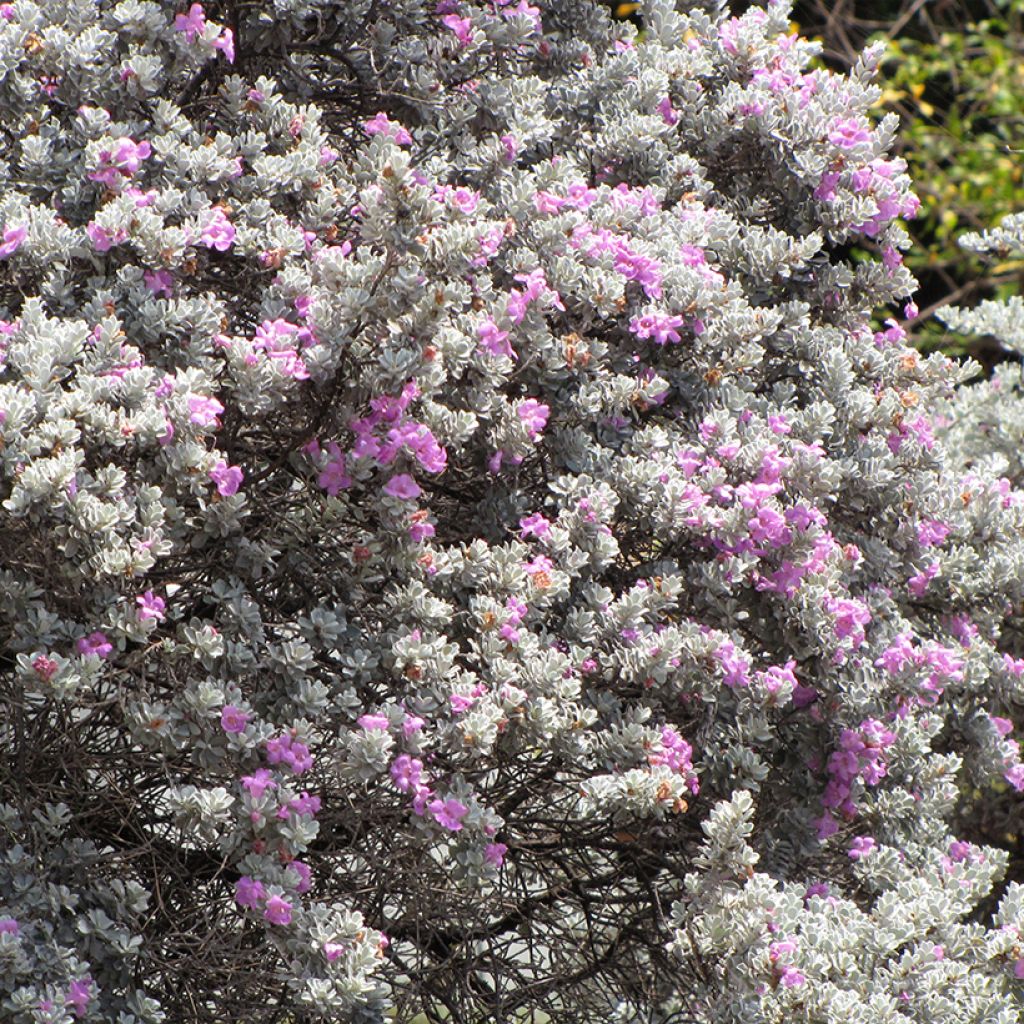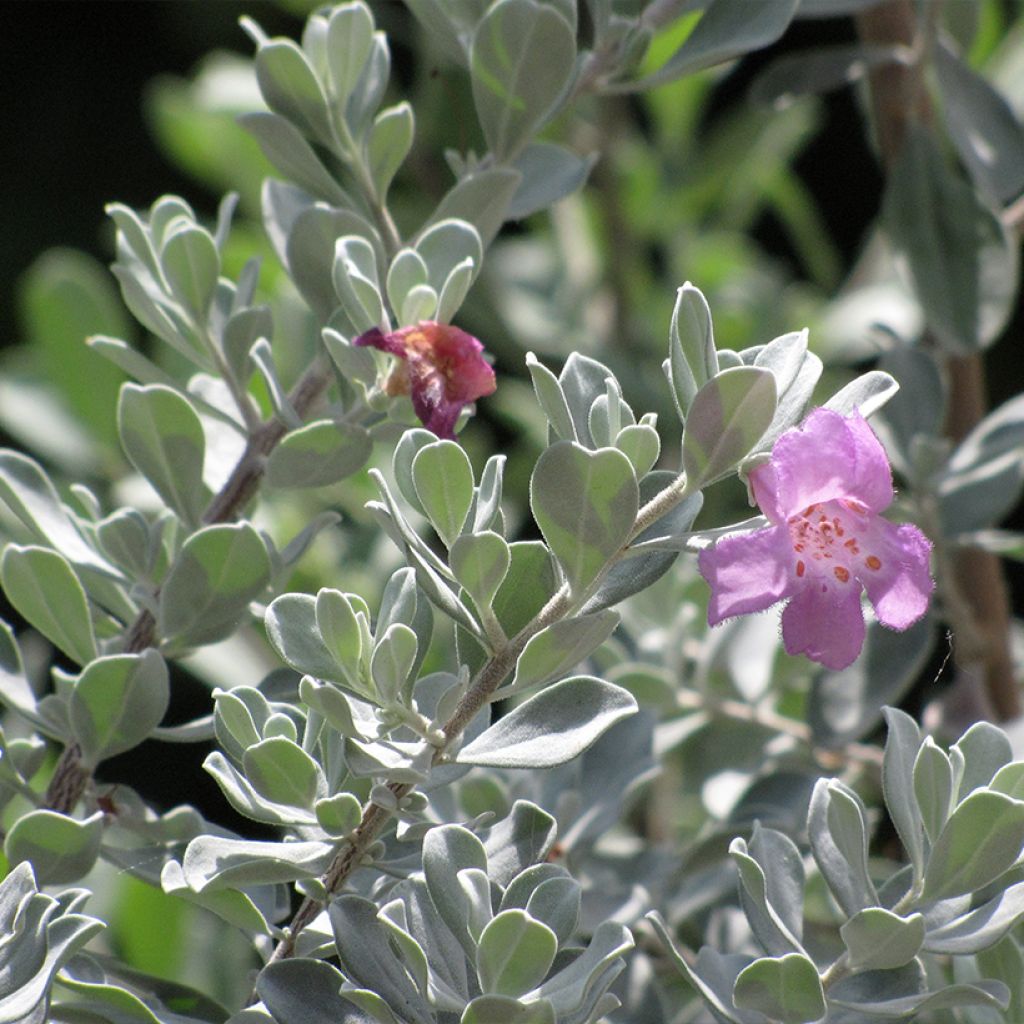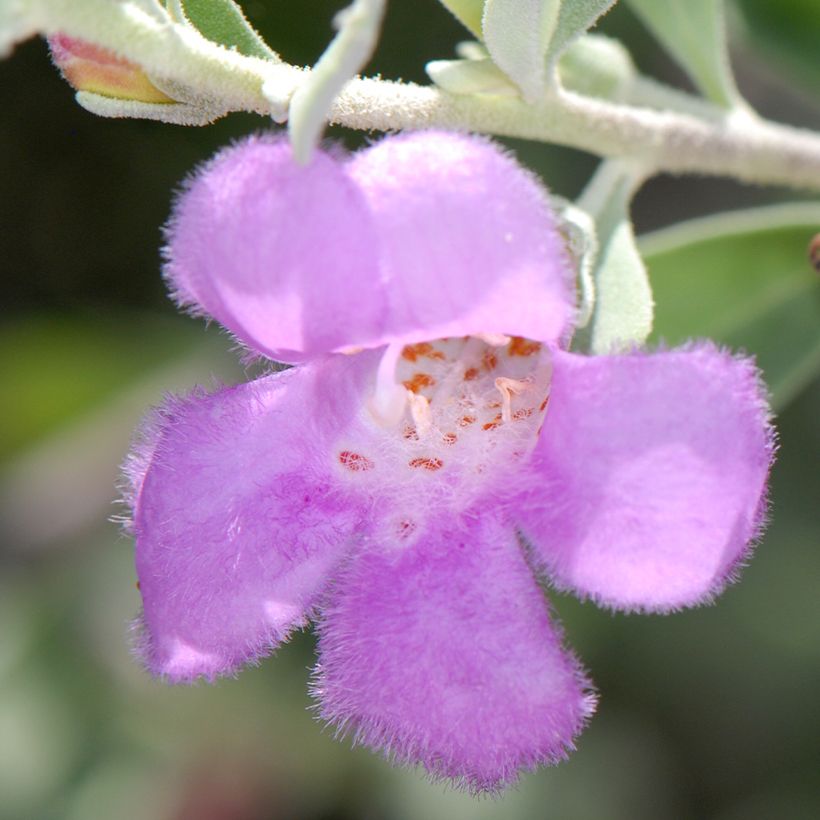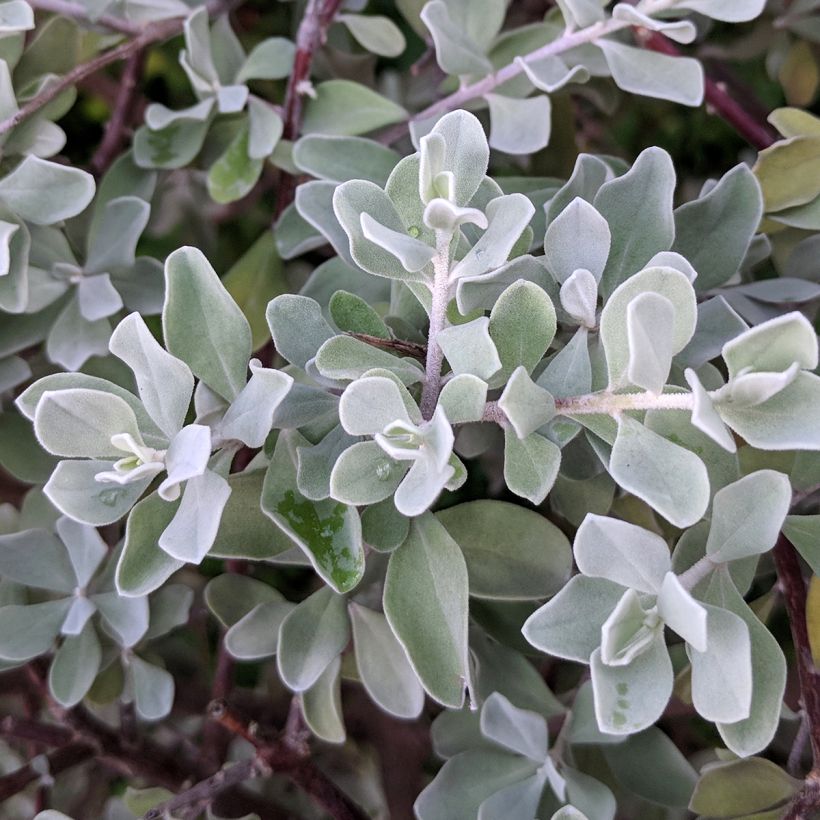

Leucophyllum frutescens


Leucophyllum frutescens


Leucophyllum frutescens


Leucophyllum frutescens


Leucophyllum frutescens
Leucophyllum frutescens
Leucophyllum frutescens
Texas Sage, Barometer Bush, Silverleaf, Cenizo
This item cannot be shipped to the selected country
Delivery charge from €5.90
More information
Schedule delivery date,
and select date in basket
This plant carries a 24 months recovery warranty
More information
We guarantee the quality of our plants for a full growing cycle, and will replace at our expense any plant that fails to recover under normal climatic and planting conditions.
From €5.90 for pickup delivery and €6.90 for home delivery
Express home delivery from €8.90.
Does this plant fit my garden?
Set up your Plantfit profile →
Description
The Desert Sage or Texas Sage, in Latin Leucophyllum frutescens, is an evergreen bush of semi-desert climate that deserves to be planted more often, particularly in very dry Mediterranean regions where it excels. It forms a beautiful bush with a dense and regular aspect covered with silver foliage and delivers a magnificent soft pink flowering at the end of summer, with the return of the rains. This rebirth accompanies that of the dry garden which often welcomes autumn with great pomp, like a second spring. It is a perfect companion for garigue plants that have the same growing requirements. You can plant it in the rockery, on a slope, in a raised flower bed, but also in a large border along a path.
The Leucophyllum frutescens is a bush from the Scrophulariaceae family. It is native to the more or less desert regions of southern Texas and northern Mexico. It is a plant very well adapted to lack of water, to coastal regions and to calcareous soils, and which withstands cold quite well under good growing conditions (down to -10/-12°C in peak). The desert sage quickly forms a large bush about 1.50 m (4 ft 11 in) high and 1 m (3 ft 4 in) wide. Its whitish, somewhat stiff stems carry a dense light grey, very bright foliage. The leaves are small, about 2.5 cm (1 in) long, oblong, slightly undulate, covered with a fine down which gives them their light colour. The underside of the leaves is almost white. The foliage persists in winter. Flowering takes place between late July and late October. It is triggered by a supply of water following a dry and hot period, thus being able to renew itself two or three times in regions where it rains little in summer, in successive waves. On the other hand, in Mediterranean gardens that experience 3 months of marked drought in summer, the flowering is unique and brief, but massive, in September-October. The small flowers are born at the leaf axil, they are small irregular villous corollas, with petals fused at the base, measuring 2 to 3 cm (0.8 to 1.2 in), light pink-mauve in colour. The flowering of this bush attracts pollinating insects.
The Leucophyllum frutescens is a plant perfectly adapted to drought: its fragile flowers hide a solid temperament and robustness to any test. It is used in flower beds, in rockeries, on a slope, but also as a low hedge to border a path for example. Create a perennial flower bed with staggered flowering by mixing the foliage and scents of lavenders (blue, white, pink), rosemary (creeping or upright), Atriplex, bushy sages, oregano, cistus, nepetas, euphorbias for dry soils (E.characias, E. cyparissias). Its combination with the Polygala myrtifolia, the Teucrium fruticans Azureum and the evergreen ceanothus Automnal Blue that bloom at the end of summer in dry gardens, is very successful. Growing in large pots is possible, by taking care of the drainage and distributing abundant but distant watering to the plant in summer, allowing the substrate to dry a little between waterings.
Report an error about the product description
Leucophyllum frutescens in pictures






Plant habit
Flowering
Foliage
Botanical data
Leucophyllum
frutescens
Scrophulariaceae
Texas Sage, Barometer Bush, Silverleaf, Cenizo
North America
Other Leucophyllum - Texas Sage
Planting and care
The Leucophyllum frutescens is planted in the spring in regions not too dry in summer, but preferably in September-October in areas where the summer is very dry and very hot. It appreciates a sunny exposure and requires a very well-drained soil, ideally stony and rather calcareous. Planting on slopes, in rockeries or in a gravel bed is preferable in climates more humid than the south of France. The desert sage adapts to sandy soils and withstands sea spray. This bush is hardy down to -10/-12°C (14/10.4 °F) at its peak, after 2 or 3 years of cultivation and provided that the soil that hosts it is dry enough. It is a semi-arid climate plant that does not tolerate heavy frosts, especially if the soil is heavy and damp. It has the same cultivation requirements as cistus and lavenders. Once well rooted, its resistance to lack of water is excellent. You can provide it with a little organic fertiliser in autumn. The flowering is triggered by the return of rains or by watering that comes after a period of marked heat and dryness. Perform light pruning after flowering to maintain a compact habit.
Pot cultivation: in a well-drained substrate, a mixture of compost, gravel and garden soil. Use a large container with holes in the bottom and arrange a drainage bed made of gravel, pottery shards or clay balls. Provide organic fertiliser in autumn. A potted plant will need to be watered regularly and deeply, but spaced apart to allow the soil to dry a little between watering. Shelter your potted plant in winter, protected from heavy frosts, in a bright but unheated room.
Planting period
Intended location
Care
This item has not been reviewed yet - be the first to leave a review about it.
Haven't found what you were looking for?
Hardiness is the lowest winter temperature a plant can endure without suffering serious damage or even dying. However, hardiness is affected by location (a sheltered area, such as a patio), protection (winter cover) and soil type (hardiness is improved by well-drained soil).

Photo Sharing Terms & Conditions
In order to encourage gardeners to interact and share their experiences, Promesse de fleurs offers various media enabling content to be uploaded onto its Site - in particular via the ‘Photo sharing’ module.
The User agrees to refrain from:
- Posting any content that is illegal, prejudicial, insulting, racist, inciteful to hatred, revisionist, contrary to public decency, that infringes on privacy or on the privacy rights of third parties, in particular the publicity rights of persons and goods, intellectual property rights, or the right to privacy.
- Submitting content on behalf of a third party;
- Impersonate the identity of a third party and/or publish any personal information about a third party;
In general, the User undertakes to refrain from any unethical behaviour.
All Content (in particular text, comments, files, images, photos, videos, creative works, etc.), which may be subject to property or intellectual property rights, image or other private rights, shall remain the property of the User, subject to the limited rights granted by the terms of the licence granted by Promesse de fleurs as stated below. Users are at liberty to publish or not to publish such Content on the Site, notably via the ‘Photo Sharing’ facility, and accept that this Content shall be made public and freely accessible, notably on the Internet.
Users further acknowledge, undertake to have ,and guarantee that they hold all necessary rights and permissions to publish such material on the Site, in particular with regard to the legislation in force pertaining to any privacy, property, intellectual property, image, or contractual rights, or rights of any other nature. By publishing such Content on the Site, Users acknowledge accepting full liability as publishers of the Content within the meaning of the law, and grant Promesse de fleurs, free of charge, an inclusive, worldwide licence for the said Content for the entire duration of its publication, including all reproduction, representation, up/downloading, displaying, performing, transmission, and storage rights.
Users also grant permission for their name to be linked to the Content and accept that this link may not always be made available.
By engaging in posting material, Users consent to their Content becoming automatically accessible on the Internet, in particular on other sites and/or blogs and/or web pages of the Promesse de fleurs site, including in particular social pages and the Promesse de fleurs catalogue.
Users may secure the removal of entrusted content free of charge by issuing a simple request via our contact form.
The flowering period indicated on our website applies to countries and regions located in USDA zone 8 (France, the United Kingdom, Ireland, the Netherlands, etc.)
It will vary according to where you live:
- In zones 9 to 10 (Italy, Spain, Greece, etc.), flowering will occur about 2 to 4 weeks earlier.
- In zones 6 to 7 (Germany, Poland, Slovenia, and lower mountainous regions), flowering will be delayed by 2 to 3 weeks.
- In zone 5 (Central Europe, Scandinavia), blooming will be delayed by 3 to 5 weeks.
In temperate climates, pruning of spring-flowering shrubs (forsythia, spireas, etc.) should be done just after flowering.
Pruning of summer-flowering shrubs (Indian Lilac, Perovskia, etc.) can be done in winter or spring.
In cold regions as well as with frost-sensitive plants, avoid pruning too early when severe frosts may still occur.
The planting period indicated on our website applies to countries and regions located in USDA zone 8 (France, United Kingdom, Ireland, Netherlands).
It will vary according to where you live:
- In Mediterranean zones (Marseille, Madrid, Milan, etc.), autumn and winter are the best planting periods.
- In continental zones (Strasbourg, Munich, Vienna, etc.), delay planting by 2 to 3 weeks in spring and bring it forward by 2 to 4 weeks in autumn.
- In mountainous regions (the Alps, Pyrenees, Carpathians, etc.), it is best to plant in late spring (May-June) or late summer (August-September).
The harvesting period indicated on our website applies to countries and regions in USDA zone 8 (France, England, Ireland, the Netherlands).
In colder areas (Scandinavia, Poland, Austria...) fruit and vegetable harvests are likely to be delayed by 3-4 weeks.
In warmer areas (Italy, Spain, Greece, etc.), harvesting will probably take place earlier, depending on weather conditions.
The sowing periods indicated on our website apply to countries and regions within USDA Zone 8 (France, UK, Ireland, Netherlands).
In colder areas (Scandinavia, Poland, Austria...), delay any outdoor sowing by 3-4 weeks, or sow under glass.
In warmer climes (Italy, Spain, Greece, etc.), bring outdoor sowing forward by a few weeks.




































